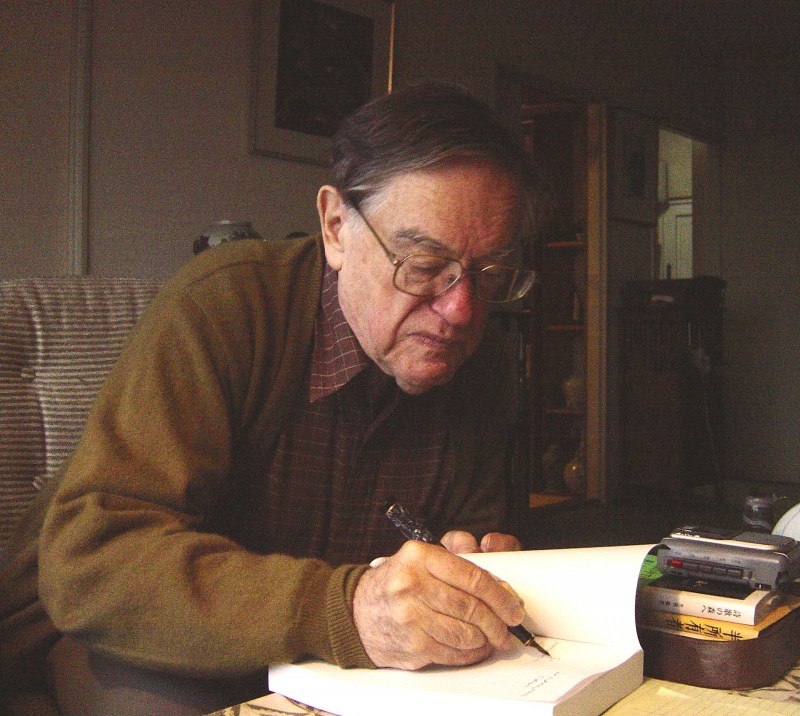
On New Year’s Day the Japan Times published a wonderful article by the renowned Japanese scholar Donald Keene, reflecting on the changes he has seen in Japan over the past 70 years. In a fascinating account he tells of life in the immediate post-war years and after; a time of much hardship, but also, a golden age in modern Japanese literature and arts. In particular though, it was his experiences as a student in early 1950’s Kyoto that grabbed my attention. Professor Keene painted a picture of a city far different from the one I know. Unlike other Japanese cities, Kyoto had been spared the ravages of wartime aerial bombardment, and the modern development that was to irrevocably change the cityscape was yet to come. How incredibly beautiful it must have been then! And what a thrill to roam through those perfectly preserved streets!
I enjoyed wandering at random in the city, fascinated by the names of places I knew from works of Japanese literature and history. The streets were surprisingly quiet, probably because at the time there were no privately owned cars in Kyoto, only company vehicles. I was delighted one day when I saw two elderly ladies happening to meet while crossing in the middle of Kawaramachi, the busiest street in the city. They politely removed their haori jackets and bowed to each other, not in the least worried by possible traffic. Of course, not everything in Kyoto was so pleasing. I saw slum areas not only around the railway station but in the middle of the city, and there were many boys eager to polish one’s shoes. But I managed to accept these sad results of the long warfare that the Japanese had suffered.
I was captivated not only by the city, but the surroundings and I visited every temple on the tourist map. I enjoyed walking along streets with rows of shops, all selling the same article, whether bamboo baskets, stone badgers, or dusty secondhand books. Most of these shops no longer exist, victims of progress.
Indeed the nostalgia is tinged with sadness. Though Professor Keene concedes that people in Kyoto now live far more comfortable lives than they did 60 years ago, he still laments the changes he has seen, and continues to see in the urban landscape.
I do miss Kyoto as it was when I first arrived in the city.
The beautiful houses in Gion grow fewer each year and will never be replaced. The side streets lined with Japanese-style houses are either mixed with dreary apartments or totally destroyed. Kyoto streets on a Sunday are now jammed with cars. No old lady is advised to cross a street without caution. Greed and a demand for convenience have taken the place of beauty…
Oh to have a time machine! I often wonder how Kyoto residents of 60 or even 50 or 40 years ago would feel if they were to pay a visit to 21st century Kyoto and witness the changes that time and rampant development have wrought. Would they marvel at our modern comforts and conveniences, and envy our lifestyle in this age of consumption? Or would they mourn the loss of the city’s former grace, and bewail the loss of local community traditions?
Perhaps they would do both.
To imagine a better future, we must look to the past. Each day, here in Fushimi, I look out my window at a parking lot, where but 30 years ago there stood a beautiful house and garden designed by the legendary architect William Vories. Once it was the pride of the family who had it built, but their descendants decided to pull it down because it made more economic sense. To go to my local supermarket I cross a canal once lined completely with cherry trees. Only a few trees now remain, most having been ripped up to make way for profitable housing. Probably, only a few people locally remember these things, and doubtless most local residents familiar with the town as it is now, would be amazed if they knew what has been lost. That’s why it is important to preserve these memories. If it was possible then, to plan and build with forethought for community and a pleasing environment, why shouldn’t it be possible now?
Looking ahead I do fervently hope that one day, both local and national government put into place policies and planning regulations that allow us to enjoy the best of old world beauty and a modern agreeable lifestyle. To dream of such a future might seem idealistic, but it’s far from impossible. Just look at this.
To read the full article by Professor Keene please visit the Japan Times website here: Donald Keene reflects on 70-year Japan experience


Leave a Reply